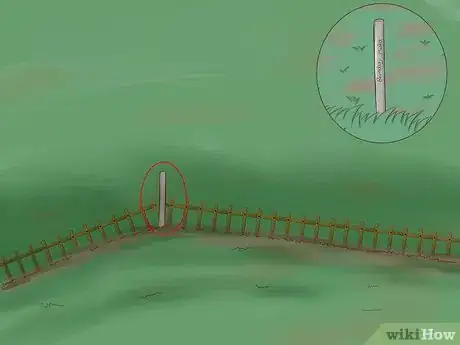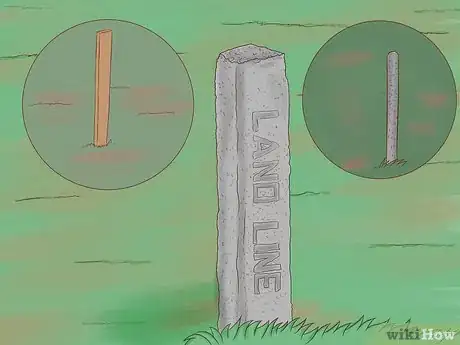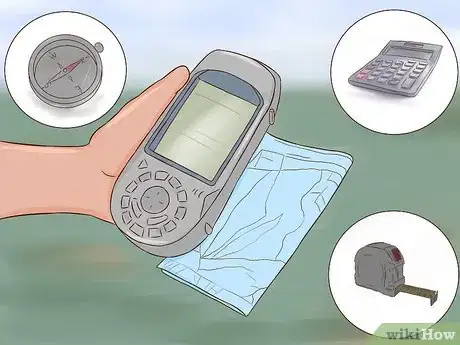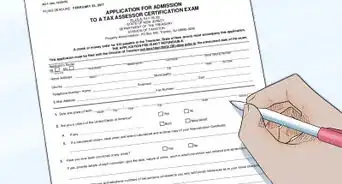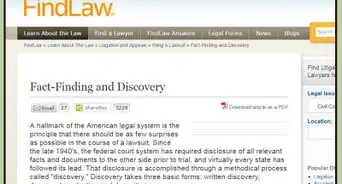This article was co-authored by Clinton M. Sandvick, JD, PhD. Clinton M. Sandvick worked as a civil litigator in California for over 7 years. He received his JD from the University of Wisconsin-Madison in 1998 and his PhD in American History from the University of Oregon in 2013.
This article has been viewed 77,604 times.
Knowing the exact boundaries of your property is very important for personal and liability reasons. However, property lines are not always indicated precisely or provided when you purchase a property. If you want to determine your property lines, however, you can closely inspect your property, deeds, and any existing survey maps. To receive the most accurate reading of your property lines, you can also enlist the services of a professional surveyor.
Steps
Looking for Existing Boundary Markers
-
1Look for metal boundary markers. When properties are surveyed, metal markers may be placed in soil to signify boundaries. These are often left in place at the corners of property lots. If you have such markers, your property may comprise the area encompassed by them.
- Most typically, these markers are made of metal rods ¾” wide and about 18” long.[1] Newer ones may have plastic caps.
- Keep in mind that these metal markers might have been buried, moved, or destroyed over time.
- You can use a metal detector to help you determine if your property has metal boundary markers. Sweep the metal detector near where you think the corners of your lot are. If you find what may be a metal boundary marker, use a spade to dig up the soil and check.
-
2Look for other types of boundary markers. Wooden stakes, concrete blocks, piles of rocks, and other objects may also be used as markers for property boundaries. These may be placed at the corners of your property lot.
- These types of markers are not necessarily accurate. For instance, piles of rocks may be moved, while wooden stakes may be used for various purposes in surveying, and not just for marking corner boundaries.
Advertisement -
3Examine any existing boundary lines. Sometimes, property boundaries are signified by fences, tree lines, walls, etc. If your property is totally or partially surrounded by such a boundary, it may fall along the property line(s). On the other hand, fences and walls might have been moved away from your property line, while tree lines may not fall exactly along them.
- If your property is wooded, you may see lines of “blazed” trees, which can indicate a property line. Blazed trees have slashes in their trunks (often painted) so that they can be easily identified.
Reading Existing Survey Maps and Deeds
-
1Study your plat map, if you have one. Typically, when properties are divided into lots, your county records this information. Often, a plat map is used, which indicates the boundary lines and measurements of each property. If you have a plat map for your property in your possession, you can easily review it to determine your property lines.
-
2Analyze your metes and bounds survey record. A metes and bounds survey is a very common type of deed for recording property borders. If you have a metes and bounds survey record of your property, you will need to read it carefully, as this type often relies on physical landmarks and may be very vague.
- For instance, a metes and bounds survey may state that a property line extends “fifty meters from the tall oak, then a 90° W turn, then seventy meters to the stone wall.” However, the “tall oak” or “stone wall” mentioned in the deed may no longer exist. For this reason, a metes and bounds survey deed is not always reliable.
-
3Check with your local government if you do not have a plat map or survey deed. Typically, property lines and plot divisions are recorded as plat maps or deeds and archived with the local county recorder or assessor. If you do not have a map or written record describing your property lines, ask the applicable office for a copy.[2] [3]
- Many counties also allow you to search databases online to find a plat map or survey deed for your property.[4]
- There may be fees for obtaining these records, which can vary widely depending upon your location.
Surveying Your Land
-
1Use basic surveying techniques for a rough estimate of your property lines. Using any information you have available—such as plat maps, old survey deeds, etc.—you may be able to lay your own property lines using basic surveying techniques. Starting from any known corner, measure out the distances and angles listed on the survey deed or plat map. Without precise equipment and training in surveying techniques, however, the result will only be a very rough estimate of your property lines, unsuitable for laying fences, etc. If you want to get a crude idea of your property lines using this method, you will need to gather equipment including:
- A compass
- A calculator
- Whatever deeds, plat maps, etc. that you have available
- A tape measure or pacing count to measure distance
-
2Contact a professional surveyor for the most accurate determination of your property lines. If you want or need a precise verification of your property lines, a professionally-trained surveyor will have the equipment and knowledge for the task. Surveyors available in your area will be advertised in typical online and hardcopy business and contractor listings; your local county assessor or recorder's office may also be able to recommend one to you.
- Employing a surveyor is advisable if you are purchasing or selling land, building a fence or other structure on or near a suspected property line, if there is a land boundary dispute, or in any other situation where a precise determination of property lines is needed.
- Costs for surveying a property can vary widely depending on your location; a typical residential lot survey may cost several hundred dollars. Costs may go up if the property boundaries are unusual or difficult in some way. A surveyor should be able to give you a cost estimate before being hired.
- When hiring a surveyor, look for one that is licensed to work in your area.
-
3Keep records of all surveying documents and information. After surveying your property, a surveyor will be able to provide you with documents including a certified drawing of the property, listing corners and occupation lines, the location of improvements (such as housing), etc. Since this information can be valuable in the future, you will want to keep all records received from the surveyor in a safe place, whether in digital or hard copy format (or both).
- You may also need to (or want to) register the new survey with your county assessor or recorder. Contact your assessor's or recorder's office if you are thinking about having a professional survey of your property.
References
- ↑ http://www.cityofapplevalley.org/FAQ.aspx?QID=79
- ↑ thelawdictionary.org/article/how-do-i-locate-my-property-lines/
- ↑ http://dclibrary.org/node/3305
- ↑ http://www.seattle.gov/cityarchives/search-collections/research-tips-and-tools/resources-for-property-research
About This Article
To determine property lines, you’ll need to see if there are any existing boundary markers. If not, you’ll need to read survey maps and deeds to determine where the lines fall. To start, walk along the property and look for small metal rods, which are often used to signify boundaries. Alternatively, there may be other types of markers like wooden stakes, concrete blocks, or even piles of rocks. If the property is wooded, you may see a line of trees with paint on them that indicate a border. If there aren’t any markers, read the metes and bounds survey report of the property, which should tell you where the borders are. Alternatively, check on your local county recorder website to find a map of the property. To learn how to hire a professional surveyor to measure the boundaries of your property, read on!
